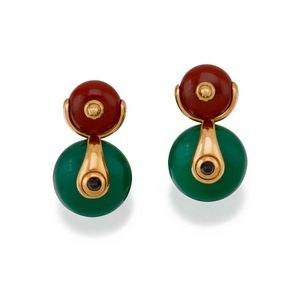Marina B Gemstone Spinner Earrings
You must be a subscriber, and be logged in to view price and dealer details.
Subscribe Now to view actual auction price for this item
When you subscribe, you have the option of setting the currency in which to display prices to $Au, $US, $NZ or Stg.
- Carnelian Glass - Carnelian glass is a type of glass that is colored red, orange, or brownish-red. It is made by adding iron oxide to the glass mixture. The color of carnelian glass can vary depending on the amount of iron oxide that is added, as well as the firing temperature. Carnelian glass is often used to make beads, jewellery, and other decorative items. It can also be used to make stained glass windows and other art objects. Carnelian glass is sometimes called "carnelian chalcedony" or "carnelian quartz."
Carnelian glass was first made in the Roman Empire. It was also made in ancient Egypt, Greece, and Mesopotamia. Carnelian glass was not made again until the Renaissance, when it became popular again. Today, carnelian glass is made in many countries around the world. - Onyx - Onyx is a form of agate, used from antiquity and popular again in the 1920s and 30s. European onyx is generally green, but can be many other colours, and can contain bands of black and/or white.
This multicoloured stone is widely used for table tops, lamp bases and in jewellery. Some types of onyx are also used for cameos of which the upper white layer is cut away to reveal the colour beneath.
This item has been included into following indexes:
-
earrings, gold
- gold and diamond drop / pendant 3,325
- gold, other 3,470
- earrings, set with - onyx 66
- Marina B. (Bulgari) (Italy) - jewellery 6
Visually similar items

Pair of 18ct gold, South Sea pearl and diamond 'Flutter' pendant earrings, Paspaley, each terminating in a drop cultured pearl measuring 15 mm, surmounted by a collet-set brilliant-cut diamond suspended from a surmount modelled as an articulated line of bu

A pair of pearl, topaz and diamond earrings by Bvlgari, from the Allegra collection, each comprising a blue topaz cut en cabochon, suspended from a cultured pearl and diamond set fitting, mounted in 18ct gold, with pouch

Pair of 18ct gold, South Sea pearl and diamond 'Ribbon diamond chain' pendant earrings, Paspaley, each terminating on a round cultured pearl measuring 11 mm surmounted by three collet-set brilliant-cut diamonds, supported from a collet-set diamond surmount

Pair gold and greenstone cuff-links plain oval panels chain linked
